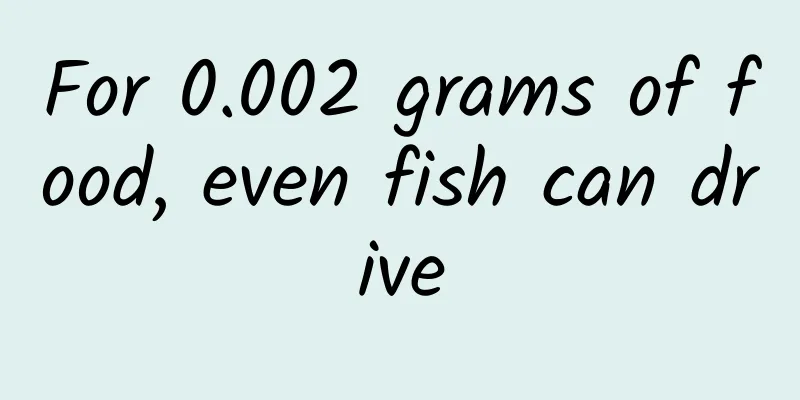For 0.002 grams of food, even fish can drive

|
Written by: Liu Fang Editor: HS Layout: Li Xuewei Can fish drive a car? Not long ago, I would have thought this scene was too beautiful to be true. However, with the encouragement of fish food, six goldfish have been able to "drive" a four-wheeled vehicle in a fish tank (FOV). Perhaps soon, you will be able to see fish on the street swimming to buy fish food by themselves. This revolutionary experiment was carried out by scientists at Ben-Gurion University in Israel. Their original intention was to find out whether the navigation ability of animals is species- and environment-specific, or whether it is an inherent survival ability that is independent of the original environment and universal. The relevant paper, titled From fish out of water to new insights on navigation mechanisms in animals, will be published in the journal Behavioural Brain Research on February 15. Goldfish driving experiment full video | Source: Ben-Gurion University Set a small goal first An animal's ability to navigate spatially is an important survival skill and key to foraging for food, finding shelter, and mates. In this experiment, scientists adopted the "domain transfer methodology", placing six goldfish in a terrestrial environment and giving them incentives to test their navigation ability in different environments. Scientists set a small target for the goldfish and marked the location of the target with pink paper. After reaching the goal, scientists will throw a 0.002 gram food particle into the water tank to let the goldfish form a reinforced memory. In order to help the goldfish achieve freedom of transportation on land, scientists installed a four-wheel drive system in the fish tank, equipped with a computer, radar system and camera. According to the direction of the goldfish swimming, the camera will activate the motor through the algorithm to drive the four-wheel vehicle forward. When the radar detects that the distance between the vehicle and the wall or obstacle is less than 20 cm, the on-board computer will brake in time to avoid a collision. Comparison of the first and highest score results | Source: Paper Needless to say, having to learn to drive in order to eat fish food is a huge challenge for goldfish. First, they need to adjust themselves and learn new sports skills, because the usual swimming posture and the way the fish muscles exert force are not enough to control the four-wheeled vehicle. Secondly, due to the refraction of light at the junction of the three optical media of air, plexiglass and water, goldfish need to overcome distorted vision and gradually find the direction. Finally, there are inherent differences in the natural structure of terrestrial and aquatic environments. Goldfish need to navigate in new environments using unrecognizable elements. Surprisingly, in order to get the 0.002 grams of food, the stubborn goldfish became familiar with the whole set of operations in a very short time. Although they took a lot of detours at the beginning, after three times a week, each time for 30 minutes, the six goldfish were able to find the destination and eat the fish food in about one minute. It's all routine The authors of the paper pointed out that if the fish started from the same place every time, it was likely that mechanical muscle memory played a role, and it could not prove that the goldfish had the ability to analyze and navigate space in real time. Therefore, they upgraded the challenge and randomly placed the fish tank four-wheeler in any position in the room. However, this did not faze the goldfish. As shown in Figure 5A, the goldfish could identify the target and reach the end point from different starting positions. Experimental upgrade | Source paper However, the trick was not over yet. To confuse the goldfish, the scientists pasted different colored paper shells on the four walls. Starting from the center of the room, the scientists conducted 15 experiments on a goldfish. As shown in Figure 5C, the goldfish ignored the interference and still ran towards the target firmly, happily eating all the fish food. Seeing that the goldfish succeeded so easily, the scientists decided to upgrade the challenge again. This time, they simply put the pink paper shell in the opposite direction to the previous one to test whether the goldfish used spatial location memory as the primary navigation condition or landmarks as the primary navigation condition. As shown in Figure 5D, the fish kept swimming to the initial position of the pink paper shell from different places, and its heart must have been full of melancholy at that time. After many failures, the goldfish seemed to suddenly realize and rushed to the pink paper shell on the other side. This result confirms that the location of the stimulus is the primary condition for goldfish navigation, and the stimulation accompanied by the stimulus is the secondary condition for goldfish navigation. After cracking the scientists' routine, the goldfish went straight to the new target position in the third experiment, indicating that the goldfish has reconstructed the internal expression of the external environment. Fish don't need bicycles As the paper states, although people have installed four-wheeled vehicles on fish tanks before, this is the first time scientists have used the "territory migration method" to study the navigation ability of fish. A series of experiments showed that the fish brain expressed space in the same way for terrestrial and aquatic environments. The paper suggests that in the future, it is possible to consider placing terrestrial animals in aquatic environments for similar experiments to draw firm conclusions about the universality of animal navigation abilities. More importantly, the goldfish in the experiment showed a high degree of adaptability to the target location. Not only could they reach the target from all directions, but they could also change their positioning of the target in time to get incentives. This shows that fish can remember environmental attributes well, rather than just identifying landmarks. They can adjust their strategies in real time and learn from failures. In Berlin in the 1970s, feminism once put forward a famous slogan: Women don't need men, just like a fish doesn't need a bicycle. This experiment tells us that a fish really does not need a bicycle, because as long as there is enough motivation, it will proudly and stubbornly drive a four-wheel vehicle to achieve land transportation freedom. References: Academic headlines |
>>: Who is Animal of the Year 2021?
Recommend
Danger! A woman was almost paralyzed after being exposed to this "stuff" for 3 months. Don't touch it...
Expert of this article: Pan Kunming, Master of Ph...
Google: Revenue growth in 4Q17 cannot stop profit decline, and the contribution of new business revenue is still negligible
Google's parent company Alphabet released its...
If you want to visit the deep earth, how deep can you go?
At the beginning of the story of "Journey to...
What are the differences in operational work between different platforms?
This question comes from a reader who said that h...
Why is the 1905 Movie Box Popular Edition so popular among movie fans?
"Movies are a continuous video image develop...
Baidu Promotion | Double 11 Market Traffic Trend & E-commerce Marketing Strategy
This article shares with you [Baidu Marketing Dou...
The forerunner of Xiaomi's gaming console? Get a sneak peek at the Xiaomi controller
After making mobile phones, tablets, TVs, and box...
A money-making project that passively acquires traffic: You can also earn 200 yuan a day by intercepting traffic and selling information from Douyin comments
It is not difficult to make money. You just need ...
The Handbook of Life Counterattack
The Handbook of Life Counterattack Thinking Selec...
The first M&A case in 2016: Mogujie and Meilishuo join hands
On the first day of the New Year, news about the ...
From China to the United States: Talking about mobile phone screen protectors
Since humans began to use mobile phones, there has...
Why has Tiktok become the public enemy of American social media?
In the eyes of mainstream American social media, ...
Which is better for making money, iOS or Android?
There is a statement that almost all mobile phone...
Is Xiaomi challenging Gree and wanting to make white goods?
The news about Lei Jun's gambling has faded a...
The most comprehensive Baidu keyword mining method!
Method 1: Use Baidu products to mine long-tail ke...









